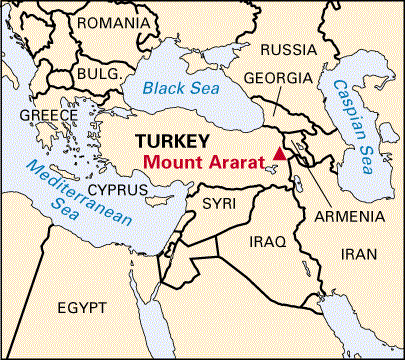|
Which mountain was the resting place of Noah’s ark? If you answered “Mount Ararat”, you are wrong. The Bible never specifically refers to Mount Ararat. “And on the seventeenth day of the seventh month the ark came to rest on the mountains of Ararat.” (Genesis 8:4, NIV) The wording of this verse implies the ark came to rest on mountains in an area called Ararat.
Ararat is mentioned again in 2 Kings 19:37 (NIV): “One day, while he was worshipping in the temple of his god Nisrok, his sons Adrammelek and Sharezer killed him with the sword, and they escaped to the land of Ararat. And Esarhaddon his son succeeded him as king.” Jerusalem was delivered from the Assyrians after the death of Sennacherib, the king of Assyria. Isaiah had predicted his death and his murderers fled to the land of Ararat. Note there is no mention of a mountain. Isaiah 37:38 records the same incident. In Jeremiah 51:27 (NIV), Ararat is one of the kingdoms summoned to destroy Babylon. “Lift up a banner in the land! Blow the trumpet among the nations! Prepare the nations for battle against her; summon against her these kingdoms: Ararat, Minni and Ashkenaz. Appoint a commander against her; send up horses like a swarm of locusts.” Again, no mountain. Although the Bible never uses the term “Mount Ararat”, it does exist. Comprised of two volcanic cones: Greater Ararat and Little Ararat, Mount Ararat is a snow-capped dormant mountain in the extreme east of Turkey, bordered by Armenia, Azerbaijan and Iran. Ararat is the Greek for the Hebrew Urartu, which was a kingdom that existed in the 9th– 6thcenturies BC in what is now Armenia. Archaeological excavations, oral history and written records have provided evidence that the two volcanoes that make up the mountain have erupted several times, the last being on 2ndJuly 1840. Possibly occurring as a result of an earthquake, the eruption killed up to 10,000 people in the region, flattening an entire village and destroying the Armenian monastery of St Jacob. Bible scholars agree that Ararat is the equivalent of the Urartu and that the word referred to the wider region rather than a specific mountain. Nevertheless, Mount Ararat has become the traditional resting place of Noah’s ark. Armenian’s began to associate the mountain with the ark’s landing place in the 11thcentury AD. Greater Ararat is the highest peak in Turkey at 5,173 m (16,854 ft). Being the highest peak, it would have been the first mountain to appear above the floodwaters; therefore, many assume the ark would have had a greater chance of landing there. Due to this traditional belief, many archaeological expeditions have taken place on the mountain in search of the ark. Some believe there may still be pieces of the ark hidden under the snow that now perpetually covers it. Over 200 people from more than 20 countries claimed to have seen the ark on Mount Ararat since 1856. The museum of Etchmiadzin Cathedral in Armenia supposedly owns a fragment of the ark. Medieval Armenian historian Movses Khorenatsi (410-90) wrote in his History of Armenia that Noah and his family first settled in Armenia before moving to Babylon. Noah’s son Japheth returned to the area around Mount Ararat and established the roots of the Armenian nation. Many Armenians still consider Japheth their founding father and, since 1918, Mount Ararat has been depicted on the Armenian coat of arms. Since 1923, Mount Ararat has belonged to Turkey; however, it was originally within the Armenian borders. After the Armenian Holocaust in 1915, when the Ottoman Empire exterminated 1.5 million Armenians, Ararat came to represent the destruction of the native population. Not only did millions lose their lives, but Armenia also lost its beloved Biblical mountain. Some Armenian political parties continue to contest the Turkey-Armenia border. In literature, Mount Ararat is written about more than any other named mountain. William Wordsworth, for example, imagined seeing the ark on the mountain in his poem Sky-prospect. Unfortunately, it is impossible to prove whether Noah’s ark landed on Mount Ararat or somewhere within the surrounding area, however, most Christian teachings continue to believe this was the ark’s final destination.
4 Comments
Terry Martinez
1/13/2021 08:54:16 am
Great information
Reply
Sibongile Tekela
2/4/2022 10:52:45 pm
The story of Noah's arc is interesting and challenging. As a South African it's interesting to know the real place where the arc landed. We still have a long way to go and learn. #Masimba Mbatha
Reply
Pravinkumar N Mundhe
6/12/2023 09:14:27 am
Thank you God ♥️♥️
Reply
Brent R Montgomery
10/19/2022 04:17:06 pm
Today I learned of Mt Aragat. On Google Earth I zoomed to find something interesting in the land slides on nearby ridges.. Has anyone heard of Mt Aragat?
Reply
Your comment will be posted after it is approved.
Leave a Reply. |
©Copyright
We are happy for you to use any material found here, however, please acknowledge the source: www.gantshillurc.co.uk AuthorRev'd Martin Wheadon Archives
June 2024
Categories
All
|

 RSS Feed
RSS Feed